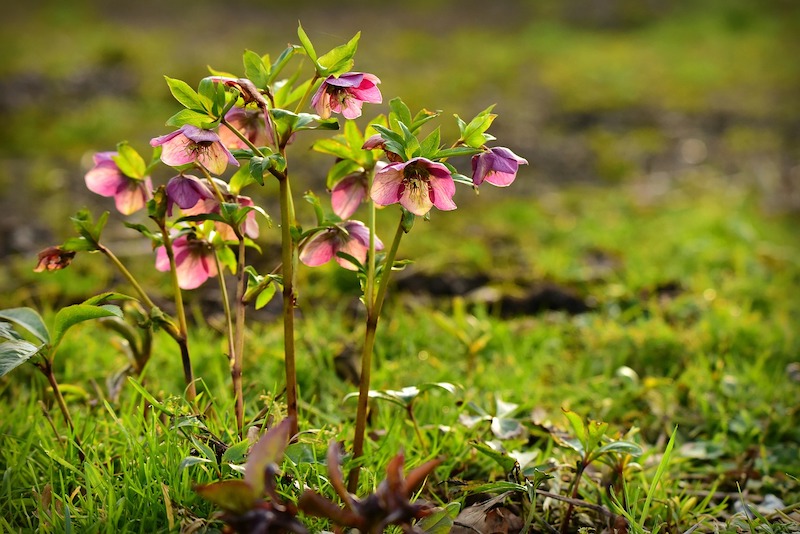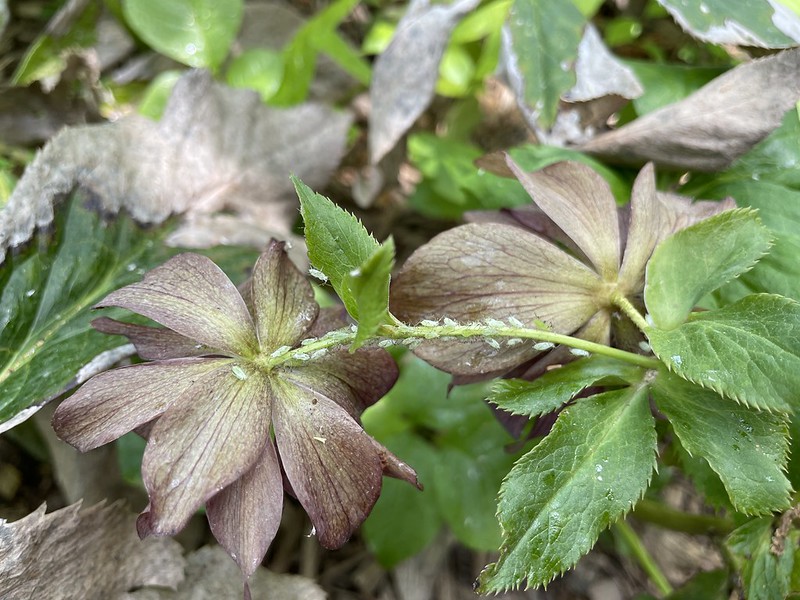Welcome heralds of spring, hellebores are among the first garden bloomers each year. Deer and rabbits do not bother the toxic hellebores. Instead, a few different species of insects can impact the health and appearance of hellebores, commonly known as Lenten rose. Slugs and snails may also occasionally plague hellebores. Luckily, most of these pest issues are relatively easy to identify and control, and rarely cause serious damage to the plant.

Common Hellebore Pests
Aphids
Multiple species of aphids can plague hellebores in the landscape. These small, pear-shaped pests typically cluster on leaf undersides and plant tips. Feeding appears as leaf curling and distortion and lack of vigor. Aphids excrete honeydew, a sticky, sugary substance that appears shiny on leaves. Ants harvest this honeydew and can protect aphids from their natural predators; an unsightly black fungus known as sooty mold also grows on honeydew. One aphid species in particular, the hellebore aphid, is particularly problematic in that it can spread an extremely damaging hellebore disease, hellebore net necrosis virus. Once present, aphids quickly multiply and become fairly easy to spot. Mature females can give live birth to young, so aphid populations grow quickly when conditions are favorable.

Photo courtesy of Matt Borden, unmodified, Flickr, Copyright CC By-SA 2.0
Treating Aphids on Hellebore
Aphids are most prevalent on tender new plant growth in spring. A forceful spray of water can often knock aphids off of a plant, so this may offer one control option. By late spring, natural enemies of aphids begin to appear in increasing numbers and can do an excellent job of keeping pests like aphids in check. Various chemicals such as insecticidal soaps and oils can also be effective.
Preventing Aphids on Hellebore
It can be difficult to prevent aphids in the landscape altogether. Instead, regular monitoring to catch the pest early before the population explodes is the most realistic prevention option. Overuse of broad-spectrum, systemic pesticides in the landscape can harm predators of aphids and should be avoided. Also avoid excessive nitrogen fertilizer applications, which promote tender new growth that attracts aphids.
Slugs and Snails
The ideal planting site for hellebores is shady and moist, which also favors slug and snail activity. These pests climb up the stem and flower stalks and feed on leaves and flowers, creating holes in leaves and petals or jagged edges. Silvery mucous trails are a telltale indicator of slug or snail presence. Damage is difficult to overlook or misidentify. Scouting in the area in the cool early morning or during overcast weather will typically reveal the culprit on the plant or in the debris around the hellebore.
Treating Slugs and Snails on Hellebore
Handpicking is one method to control slugs and snails. This can be time consuming but very effective if done regularly until the pest population is brought in check. To attract snails and slugs, place boards or inverted melon rinds throughout the garden and then scrape the accumulated pests off daily. Barriers made with copper around plants or the garden bed will keep out these pests. There are also commercially available chemical control options including products that contain iron phosphate and ferric sodium EDTA. These are typically sprinkled around the base of affected plants and are most effective when the weather is mild and there is light rainfall or irrigation.
Preventing Slugs and Snails on Hellebore
The best way to prevent slugs and snails is to eliminate daytime hiding areas for these pests near the hellebores. Dense groundcovers, boards, thick mulch, and low-growing tree and shrub branches all provide moist shelter for slugs and snails. Using drip irrigation or precise hand watering rather than a sprinkler system will also help to control the moisture level in an area. Also, irrigating early in the morning will minimize the amount of time the landscape stays moist and favors slug and snail activity.
Leafminers
Leafminers are occasional pests on hellebore. Damage from this pest is very easy to diagnose. Leafminer larvae feed within leaves, causing patches or tunnels of dead tissue. The damage caused by leafminers is typically superficial and will not significantly impact hellebore health. Natural enemies also help to keep this pest under control. However, if leafminers have historically been present in a site and new growth is being severely damaged in early spring, control may be warranted.
Treating Leafminers on Hellebore
Removing and destroying infested leaves as soon as damage appears will help to limit subsequent generations of leafminers throughout the summer. Where the appearance of the hellebores is particularly important, pesticide applications can prevent some amount of leafminer activity. Pesticides will not affect larvae feeding within the leaves, but will impact adult flies. Choose a low-impact pesticide like spinosad, begin applications in spring, aim for good coverage of leaves, and apply at regular intervals, as directed on the product label. Broad-spectrum, persistent insecticides will control leafminers, but they will also impact the populations of the beneficial insects that effectively control leafminers.
Preventing Leafminers on Hellebore
Good sanitation is an important aspect of preventing leafminers on hellebore. Removing and destroying infested leaves as soon as miners appear will keep the population in check. Keep the landscaping bed and nearby gardens free of weeds that can act as a food source for leafminers. A physical barrier in the form of fine mesh netting can keep adult flies away from plants, but may be just as unsightly as leafminer feeding.
Hellebore Pests Chart
|
Pest |
Identifying |
Treating |
|
Aphids |
Small, pear-shaped pests typically cluster on leaf undersides and plant tips |
Forceful spray of water can knock aphids off |
|
Slugs and Snails |
Silvery mucous trails, holes in leaves and petals or jagged edges |
Place boards or inverted melon rinds in the garden, scrape the accumulated pests off daily |
|
Leafminers |
Small larvae, usually white or pale yellow |
Remove and destroy infested leaves as soon as damage appears |
Sources:
"Helleborus niger." North Carolina Extension Gardener Plant Toolbox. plants.ces.ncsu.edu
"Helleborus orientalis." North Carolina Extension Gardener Plant Toolbox. plants.ces.ncsu.edu
 |
Author Angela Ryczkowski - Published 7-15-2023 |
